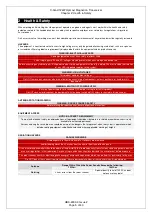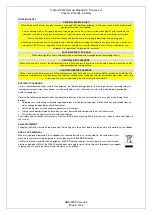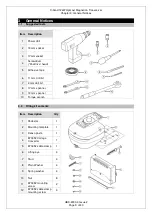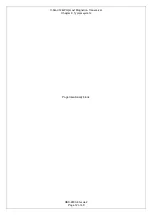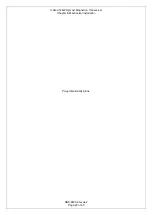
X-band 12kW Upmast Magnetron Transceiver
Chapter 5: Mechanical installation
HBK-2300-3 Issue 2
Page 13 of 40
5 Mechanical installation
5.1
Location requirements
When selecting a location for the scanner/ transceiver it is important to consider a number of factors.
Additional information on the sighting and position of a radar system is available from Kelvin Hughes
Ltd on request.
HORIZONTAL POSITION
The radar scanner should be positioned as near as possible to your vessels centreline.
HEIGHT
The radar scanner should normally be mounted as high as practical above the waterline.
Mount the scanner above head height out of range of personnel, to avoid mechanical danger and
minimize exposure to electromagnetic radiation.
Radar operates at the line-of-sight, so a high mounting position gives better long range
performance.
Surrounding large objects, in the same horizontal plane, can interfere with the radar signal and
can cause blind areas or shadow sectors and false targets on the radar display (see below).
SHADOW AREAS AND FALSE ECHOES
Mount the radar scanner away from large structures or equipment, such as engine stacks,
searchlights, horns, or masts. These objects may cause shadow areas and false echoes. For
example, if you mount the radar scanner on a mast, echoes from other targets may be reflected from
the mast. It is particularly important to avoid shadow areas near the bow. Raising or even lowering the
radar scanner may help to reduce these effects.
In shadow areas beyond the obstruction there will be a reduction of the beam intensity. There may be
a blind sector if the beam intensity is not sufficient to obtain an echo from an object. This may occur
even at close range. For this reason the angular width and relative bearing of any shadow area must
be determined at installation. You may be able to detect shadow areas or false echoes on your
multifunction display. For example, sea clutter can be used as a good indicator of blind arcs. Dark
sectors on the radar display indicate possible shadowed areas. This information should be posted
near the display unit and operates must be alert for targets in these blind areas.
ACCESS
The radar scanner should be easily accessible to allow maintenance to be carried out safely.
Sufficient clearance must be allowed to fully open the scanner unit for maintenance and service.
MULTIPLE RADAR SCANNERS
If two radar scanners are installed at different locations in a dual radar system, care should be taken
to allow for the difference in position of the radars when switching between the transceivers. This is
especially noticeable at short ranges on larger vessels.
CABLES
All cables should be adequately clamped and protected from physical damage and exposure to heat.
Avoid running cables through bilges or doorways, or close to moving or hot objects. Where a cable
passes through an exposed bulkhead or deck head, use a watertight feed-through.
MOUNTING PLATFORM
The radar scanner must be mounted on a rigid and stable platform. The platform must be capable of
supporting the mass and inertia of the radar scanner under seagoing conditions. The platform should
not twist (causing bearing errors) or be subjected to excessive vibration.





